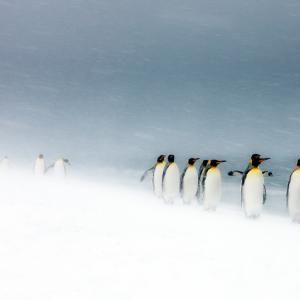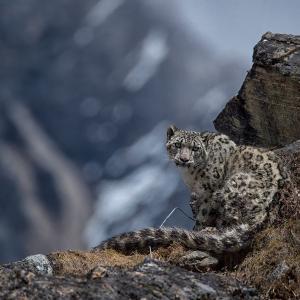
The A to Z of Climate Change
Climate change can be a complicated and confusing topic. For many people it seems abstract and irrelevant to their lives, but with so many species, habitats and people being impacted it’s becoming ever more important to engage with.
I’m sharing my A-Z of climate change, covering many of the terms you’re likely to see in the media today. I was onto a pretty good start with Adaptation, Biodiversity, Climate Change and Deforestation. Sometimes I had to choose between two or more good options, for example should “R” be Renewables, or Range shifts, or Rainforest? Towards the end it got tougher – my “Q” is obscure and “X” more or less beat me but my “Z” let me talk about coral bleaching. I hope you find this A-Z of climate change inspiring and informative.
A. Adaptation
The adjustment in natural or human systems to actual or expected climate and its impacts. Adaptation efforts include the use of drought-resistant crops, adoption of water conservation measures and building of storm surge barriers. Wildlife try to follow their preferred climate in behaviour called range shifting, which is also an adaptation.
B. Biodiversity
Biodiversity is the variety of plant and animal life in a particular habitat. Climate change and biodiversity are interconnected – climate change can amplify existing threats and increase biodiversity loss, with negative consequences for human well-being, but biodiversity, through the ecosystem services it supports, also makes an important contribution to both climate-change mitigation and adaptation.
C. Climate change
The global or regional-scale change to long-term weather patterns, and global warming is the long-term trend of rising average temperatures. The Earth’s climate has changed throughout history but, since the industrial revolution, warming, and related climate changes, are largely attributed to higher atmospheric concentration of carbon dioxide (CO2) caused mainly by humans burning fossil fuels for energy.
D. Deforestation
A staggering 10 million hectares are deforested each year (nearly five times the size of Wales). Deforestation and forest degradation leads to the release of carbon stored in the trees and are a big source of man-made greenhouse gas emissions and driver of climate change.
E. Energy
Clean and affordable is important for sustainable development. We need to transform the global energy-system to 100% renewable energy sources such as wind and solar from one reliant on burning fossil fuels such as coal, oil and gas, as energy from fossil fuels is globally the biggest contributor to climate change.
F. Food
Food and the agriculture system are big drivers of climate change and biodiversity loss, contributing around a quarter of global greenhouse gas emissions. Changing patterns of consumption to eat less meat and reducing food loss and waste are important ways of cutting emissions from our food system.
G. The greenhouse effect
Is the warming of the lower atmosphere due to certain gases allowing sunlight through, which then reflects off the Earth’s surface as infrared radiation, and becomes trapped. Without the natural greenhouse effect the Earth would be very cold, but the additional accumulation of man-made greenhouse gases is leading to global warming and its adverse impacts.
H. Heat waves
Heat waves are periods of abnormally hot weather and are associated with an increased number of deaths. Heatwaves, drought and heavy rainfall are examples of extreme weather events. Global warming increases the likelihood of extremely hot days and for some extreme weather events, science can quantify probability or intensity changes due to climate change.
I. Impacts
Impacts of climate change are occurring and at record rates, with risks increasing with global warming. Climate impacts include more intense heat waves, shifting seasons, rising sea-levels and disappearing Arctic sea-ice. Globally climate change impacts hit the poorest and most vulnerable hardest. Two of the greatest direct climate change-related threats for the UK are large increases in flood risk and exposure to high temperatures.
J. Just transition
A Just transition to a low-carbon and climate-resilient economy, refers to the concept of providing workers with decent jobs, while protecting the environment. During the transition there will be fewer jobs in high-carbon industries and more in green technology.
The Keeling Curve shows atmospheric CO2 levels measured at Hawaii’s Mauna Loa Observatory. Human activities, such as burning fossil fuels, has led to a ~30% increase from 315 parts per million (ppm) in 1958 to over 411 ppm in 2020.
The famous Keeling Curve, showing the increase in atmospheric carbon dioxide levels since monitoring began © Scripps Oceanography]
L. Loss and damage
Loss and damage refers to the negative impacts of climate change that occur regardless of efforts to cut global greenhouse gas emissions and efforts to adapt. Loss and damage can result from extreme events such as tropical storms and slow-onset events such as sea-level rise. Developing countries are particularly vulnerable.
M. Mitigation
Mitigation refers to efforts to cut the rate of man-made emissions of greenhouse gas into the atmosphere. Climate change mitigation includes actions such as switching from polluting fossil fuels to clean renewable energy sources, improving energy efficiency, lowering consumption, improving transport and limiting emissions from international aviation and shipping, and stopping deforestation.
N. Nature-based Solutions
Nature-based Solutions are “actions to protect, sustainably manage and restore natural or modified ecosystems that address societal challenges effectively and adaptively, simultaneously providing human well-being and biodiversity benefits”. Strong and healthy natural ecosystems help fight climate change and build resilience to climate impacts. To limit climate change we must both decarbonise our economy and draw down carbon from the atmosphere using nature-based solutions such as conserving and restoring forests and grasslands.
O. Oceans
The world’s oceans have taken up more than 90% of the excess heat in the climate system, and absorbed up to 30% of the CO2 we pump into the atmosphere which keeps atmospheric concentrations and hence global warming lower, but as a consequence causes ocean acidification, which can dissolve shells of tiny marine species, damaging the food chain.
P. Paris Agreement
2015 saw a historic deal between 195 countries to address climate change. The Paris Agreement aims to keep global warming to well below 2°C above pre-industrial levels and to pursue efforts to 1.5°C. It also highlights the importance of adaptation and international finance. In aggregate, country pledges to cut emissions (known as Nationally Determined Contributions or NDCs) is projected to lead to global warming of around 3°C.
Q. QELROs
Also known as ‘Quantified Emission Limitation and Reduction Objectives’, QELROs are the targets which many developed countries committed to as part of the Kyoto Protocol under the UNFCCC.
R. Range shifts
Plants and animals survive and reproduce in areas with a suitable climate. As the planet warms those species fast enough typically try to track their favoured climate towards the poles and uphill; those unable to – due low dispersion rates or barriers such as mountains or cities – may face local extinction.
S. Sea-level rise
This has huge adverse impacts on people and wildlife in coastal and low-lying areas – including submergence, coastal erosion, saltwater intrusion and increases in extreme waves. The global mean sea level increased 16cm between 1902 and 2015 and is rising by around 3.3mm per year – mainly due added water from melting ice sheets and glaciers and the thermal expansion of seawater.
T. Temperatures
Human activities have caused ~1°C of global warming above pre-industrial levels, with the warmest five years on record being since 2015. Temperature rise varies in different regions of the globe, with warming in the Arctic more than double the global average. Every half a degree warming matters and to avoid the worst impacts of climate change global average surface temperature rise should be limited to 1.5°C.
U. UNFCCC
The 1994 United Nations Framework Convention on Climate Change has the ultimate objective to prevent “dangerous” human interference with the climate system. The UNFCCC spawned two further treaties to pursue this objective – the Kyoto Protocol, which entered into force in 2005, and the Paris Agreement negotiated in 2015.
V. Vulnerability
The Vulnerability of a species describes the degree to which it will survive under climate change. The Intergovernmental Panel on Climate Change (IPCC) define vulnerability as the propensity or predisposition to be adversely affected by climate change; it encompasses a variety of concepts including sensitivity or susceptibility to harm and lack of capacity to cope and adapt.
W. Water
Water is an important medium through which climate change influences the Earth’s ecosystem – a warmer atmosphere can hold more moisture. Freshwater resources can be impacted by climate change with concerns including rainfall reliability (persistent droughts for some areas and repeated floods in others), groundwater levels and decline in water supplies stored in glaciers and snow cover.
X. X
The first unknown quantity.
Y. Yearly greenhouse gas emissions
Global emissions are estimated at over 50 billion tonnes CO2 equivalent. UK greenhouse gas emissions in 2018 were 451 million tonnes CO2 equivalent; this is 43% below 1990 levels (however UK consumption-based emissions or carbon footprint is significantly higher).
Z. Zooxanthellae
Zooxanthellae are algae living in the tissue of healthy coral. When water is too warm, corals expel the zooxanthellae and turn white – this is called coral bleaching. Marine heatwaves have resulted in large-scale coral bleaching events at increasing frequency with 2014-17 witnessing the most severe, widespread, and longest-lasting global-scale coral bleaching event ever recorded.
In my A-Z I’ve tried to cover some of the reasons we need to act on climate now and some issues that climate change encompasses.
Climate change is a global problem, and it is vital we ensure that politicians and business leaders in the UK and around the world continue to see dealing with climate change a priority.
To find out more about climate change and WWF’s climate change and energy work take a look at our climate pages.
 Here are 10 myths about climate change
Here are 10 myths about climate change
 10 reasons why climate change is an important issue
10 reasons why climate change is an important issue
 WWF Guide to Greenwashing
WWF Guide to Greenwashing
 Plastic - the never ending story
Plastic - the never ending story